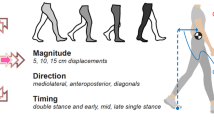Abstract
Purpose
In this study, natural human motion was modeled using a three-dimensional simulation involving a biped robot. Exoskeleton assistance was examined through the extraction and analysis of kinematic and dynamic parameters. The present findings can serve as a reference for a study on exoskeleton design in which user effort is considered.
Methods
A biped robot simulator of human gait was constructed. A participant’s movement was recorded using a Vicon motion capture system. The effect of exoskeleton assistance on gait performance was evaluated under admittance control for user interaction.
Results
In the simulation of a squatting motion, the exoskeleton helped the user lift a 50-lb weight without the user exerting any additional effort. Exoskeleton energy consumption was also examined. Virtual parallel bars effectively assisted the biped in simulating natural walking gait. Adjusting the body’s center of gravity helped reduce the robot’s dependence on the parallel bars, as did changing the walking speed, which allowed the body to catch up with leg motion.
Conclusion
The biped effectively simulated the participant’s motion when he did not walk away from where he stood. Special care was taken because the biped robot lacked the degrees of freedom of human motion. Notably, virtual parallel bars were successfully used to help the robot walk with a natural gait. This method can be applied in scenarios mimicking humans moving with assistance.




















Similar content being viewed by others
Data availability
The human gait data can be downloaded from the following server: https://drive.google.com/drive/folders/1ZbZGFScVn26bY0djE1O-2lcDpZPYojJ5?usp=sharing
Code availability
The system is developed in MATLAB.
References
Dollar, A. M., & Herr, H. (2008). Lower extremity exoskeletons and active orthoses: Challenges and state-of-the-art. IEEE Transactions on Robotics, 24(1), 144–158. https://doi.org/10.1109/TRO.2008.915453
Kawamoto, H., Hayashi T., Sakurai, T., Eguchi, K., Sankai, Y. (2009) Development of single leg version of HAL for hemiplegia. In: Proceedings of the 31st Annual International Conference of the IEEE Engineering in Medicine and Biology Society: Engineering the Future of Biomedicine, EMBC 2009, pp 5038–5043. https://doi.org/10.1109/IEMBS.2009.5333698
Talaty, M., & Esquenazi, A. (2013). Briceno JE differentiating ability in users of the ReWalkTM powered exoskeleton: An analysis of walking kinematics. IEEE International Conference on Rehabilitation Robotics. https://doi.org/10.1109/ICORR.2013.6650469
Swank, C., Sikka, S., Driver, S., Bennett, M., & Callender, L. (2020). Feasibility of integrating robotic exoskeleton gait training in inpatient rehabilitation. Disability and Rehabilitation: Assistive Technology, 15(4), 409–417. https://doi.org/10.1080/17483107.2019.1587014
Farris, R. J., Quintero, H. A., Murray, S. A., Ha, K. H., Hartigan, C., & Goldfarb, M. (2014). A preliminary assessment of legged mobility provided by a lower limb exoskeleton for persons with paraplegia. IEEE Transactions on Neural Systems and Rehabilitation Engineering, 22(3), 482–490. https://doi.org/10.1109/TNSRE.2013.2268320
Rupala BS, Singla AS, Virk GS (2016) Lower limb exoskeletons: a brief review. Paper presented at the IJSRD Conference on Mechanical Engieering & Technology (COMET), Varanasi, Pradesh, Utter, 1/2016
Kazerooni, H. (2007). Human augmentation and exoskeleton systems in Berkeley. International Journal of Humanoid Robotics, 4(3), 575–605. https://doi.org/10.1142/S0219843607001187
Yan, T., Cempini, M., Oddo, C. M., & Vitiello, N. (2015). Review of assistive strategies in powered lower-limb orthoses and exoskeletons. Robotics and Autonomous Systems, 64, 120–136. https://doi.org/10.1016/j.robot.2014.09.032
van den Bogert, A. J. (2003). Exotendons for assistance of human locomotion. BioMedical Engineering Online. https://doi.org/10.1186/1475-925X-2-17
Agrawal SK, Banala SK, Fattah A, Scholz JP, Krishnamoorthy V, Hsu WL A gravity balancing passive exoskeleton for the human leg. In: Robotics: Science and Systems, 2007. pp 185–189
Agrawal, S. K., Banala, S. K., Fattah, A., Sangwan, V., Krishnamoorthy, V., Scholz, J. P., & Hsu, W. L. (2007). Assessment of motion of a swing leg and gait rehabilitation with a gravity balancing exoskeleton. IEEE Transactions on Neural Systems and Rehabilitation Engineering, 15(3), 410–420. https://doi.org/10.1109/TNSRE.2007.903930
Walsh, C. J., Pasch, K., Herr, H., (2006) An autonomous, underactuated exoskeleton for load-carrying augmentation. In: 2006 IEEE/RSJ International Conference on Intelligent Robots and Systems, pp 1410–1415. https://doi.org/10.1109/IROS.2006.281932
Dariush, B. (2005) Analysis and simulation of an exoskeleton controller that accommodates static and reactive loads. In: Proceedings - IEEE International Conference on Robotics and Automation. pp 2350–2355. https://doi.org/10.1109/ROBOT.2005.1570464
Van Dijk, W., & Van Der Kooij, H. (2011). Hekman E A passive exoskeleton with artificial tendons: Design and experimental evaluation. IEEE International Conference on Rehabilitation Robotics. https://doi.org/10.1109/ICORR.2011.5975470
Collo, A., Bonnet, V., Venture, G. (2016) A quasi-passive lower limb exoskeleton for partial body weight support. In: Proceedings of the IEEE RAS and EMBS International Conference on Biomedical Robotics and Biomechatronics. (pp 643–648). doi:https://doi.org/10.1109/BIOROB.2016.7523698
Shi, D., Zhang, W., Zhang, W., & Ding, X. (2019). A review on lower limb rehabilitation exoskeleton robots. Chin J Mech Eng, 32(1), 74. https://doi.org/10.1186/s10033-019-0389-8
Sado, F., Yap, H. J., Ghazilla, R. A. R., & Ahmad, N. (2018). Exoskeleton robot control for synchronous walking assistance in repetitive manual handling works based on dual unscented kalman filter. PLoS One. https://doi.org/10.1371/journal.pone.0200193
Song, G., Huang, R., Cheng, H., Chen, Q. (2019) Learning coupled parameters with continuous domains for human-powered lower exoskeleton. In: ICARM 2018 - 2018 3rd International Conference on Advanced Robotics and Mechatronics. (pp 189–194) https://doi.org/10.1109/ICARM.2018.8610692
Xi, R., Zhu, Z., Du, F., Yang, M., Wang, X., Wu, Q. (2016) Design concept of the quasi-passive energy-efficient power-assisted lower-limb exoskeleton based on the theory of passive dynamic walking. In: 2016 23rd International Conference on Mechatronics and Machine Vision in Practice (M2VIP), (pp 1–5). https://doi.org/10.1109/M2VIP.2016.7827278
Aoustin, Y., & Formalskii, A. M. (2018). Walking of biped with passive exoskeleton: Evaluation of energy consumption. Multibody System Dynamics, 43(1), 71–96. https://doi.org/10.1007/s11044-017-9602-7
Lim, I.-s, Kwon, O., & Park, J. H. (2014). Gait optimization of biped robots based on human motion analysis. Robotics and Autonomous Systems, 62(2), 229–240. https://doi.org/10.1016/j.robot.2013.08.014
Chen, Q., Cheng, H., Yue, C., Huang, R., & Guo, H. (2018). Dynamic balance gait for walking assistance exoskeleton. Applied Bionics and Biomechanics, 2018, 7847014. https://doi.org/10.1155/2018/7847014
Ghan, J., Steger, R., & Kazerooni, H. (2006). Control and system identification for the Berkeley lower extremity exoskeleton (BLEEX). Advanced Robotics, 20(9), 989–1014. https://doi.org/10.1163/156855306778394012
Yagn, N. (1890) Apparatus for facilitating walking, running, and jumping. U.S.A. Patent 440684, 1890/11/18
Reed, M.K. LIFESUIT exoskeleton gives the gift of walking so they shall walk. In: Proceedings of the 4th IEEE Global Humanitarian Technology Conference, GHTC 2014, 2014. pp 382–385. doi:https://doi.org/10.1109/GHTC.2014.6970309
Acknowledgements
This manuscript was edited by Wallace Academic Editing.
Funding
This research is support by the National Chung-Shan Institute of Science and Technology under Grant No: NCSIST-401-V101(109) and in part by the Ministry of Science and Technology, Taiwan under Grant No: 108-2221-E-002-149-MY3.
Author information
Authors and Affiliations
Corresponding author
Ethics declarations
Conflict of interest
The authors report no conflict of interest.
Rights and permissions
About this article
Cite this article
Lee, CY., Lan, S.C., Lin, JJ. et al. Realization of Natural Human Motion on a 3D Biped Robot For Studying the Exoskeleton Effective. J. Med. Biol. Eng. 41, 856–869 (2021). https://doi.org/10.1007/s40846-021-00634-y
Received:
Accepted:
Published:
Issue Date:
DOI: https://doi.org/10.1007/s40846-021-00634-y




